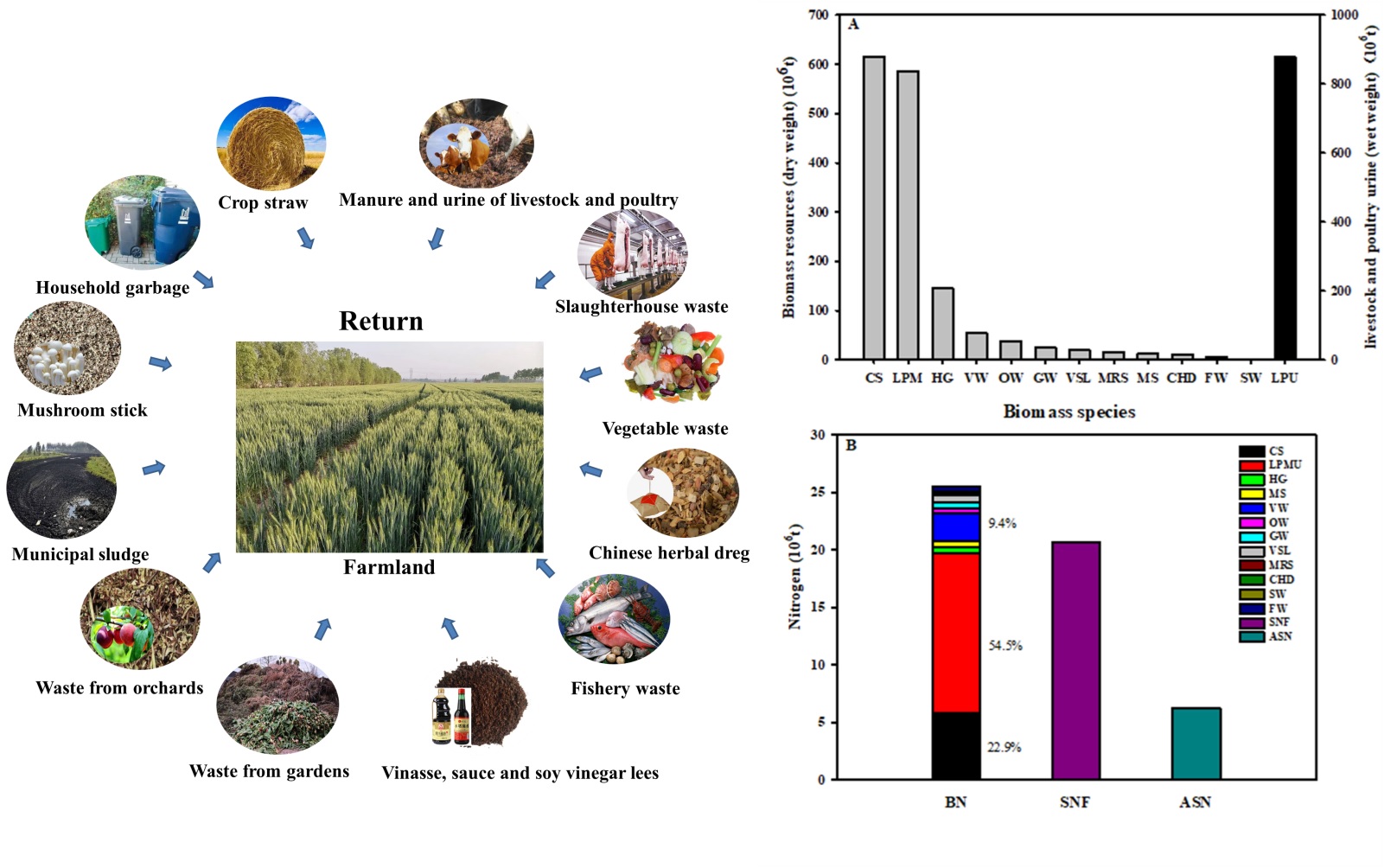Currently, China is vigorously advocating replacing chemical fertilizers with organic fertilizers. Exploring the available sources of organic fertilizers has become one of the hottest research issues. Theoretically, all biomass resources originally produced by photosynthesis and their biodegradable derivatives such as crop straw, vegetable waste, livestock and poultry manure, etc., can be utilized as organic fertilizers which have huge potentials in replacing chemical fertilizers. However, it is still not clear how large the biomass nitrogen reservoir is and its potential in replacing chemical fertilizers in a certain region or country.
A research group led by Professor Gaoming Jiang from the Institute of Botany, Chinese Academy of Sciences, has made a big progress in making clear the biomass nitrogen reservoir and its potential in replacing chemical fertilizers. They took China as a case, investigated 12 kinds of biomass resources and calculated their nitrogen reservoirs. The scientists found that the total amount of biomass (dry weight) in China was about 1.527 billion t·a-1 and the urine of animal (wet weight) was about 878.75 million t·a-1. The sum of them contained 25.53 million t·a-1 nitrogen, being 4.12 times that of synthetic nitrogen fertilizers (6.20 million t·a-1) actually absorpted by agriculture plants in China. For biomass nitrogen, the biggest contributor came from the manure and urine of livestock and poultry (54.5%), followed by crop straw (22.9%), vegetable waste (9.4%), vinasse, vinegar and soy sauce lees (2.3%), municipal sludge (2.2%), garden waste (2.1%), urban and rural household garbage (1.8%), orchard waste (1.8%), fishery waste (1.6%), Chinese herbal dreg (0.64%), mushroom stick (0.63%), with slaughterhouse waste being merely 0.13%.
The study, co-founded by the National Key Research and Development Program of Ministry of Science and Technology of the People’s Republic of China and the National Natural Science Foundation of China, has been recently published online in Renewable and Sustainable Energy Reviews.

12 kinds of biomass resources and their nitrogen reservoirs
Articlelink: https://doi.org/10.1016/j.rser.2020.110215
Contact: Email: jgm@ibcas.ac.cn
Institute of Botany, the Chinese Academy of Sciences
Currently, China is vigorously advocating replacing chemical fertilizers with organic fertilizers. Exploring the available sources of organic fertilizers has become one of the hottest research issues. Theoretically, all biomass resources originally produced by photosynthesis and their biodegradable derivatives such as crop straw, vegetable waste, livestock and poultry manure, etc., can be utilized as organic fertilizers which have huge potentials in replacing chemical fertilizers. However, it is still not clear how large the biomass nitrogen reservoir is and its potential in replacing chemical fertilizers in a certain region or country.
A research group led by Professor Gaoming Jiang from the Institute of Botany, Chinese Academy of Sciences, has made a big progress in making clear the biomass nitrogen reservoir and its potential in replacing chemical fertilizers. They took China as a case, investigated 12 kinds of biomass resources and calculated their nitrogen reservoirs. The scientists found that the total amount of biomass (dry weight) in China was about 1.527 billion t·a-1 and the urine of animal (wet weight) was about 878.75 million t·a-1. The sum of them contained 25.53 million t·a-1 nitrogen, being 4.12 times that of synthetic nitrogen fertilizers (6.20 million t·a-1) actually absorpted by agriculture plants in China. For biomass nitrogen, the biggest contributor came from the manure and urine of livestock and poultry (54.5%), followed by crop straw (22.9%), vegetable waste (9.4%), vinasse, vinegar and soy sauce lees (2.3%), municipal sludge (2.2%), garden waste (2.1%), urban and rural household garbage (1.8%), orchard waste (1.8%), fishery waste (1.6%), Chinese herbal dreg (0.64%), mushroom stick (0.63%), with slaughterhouse waste being merely 0.13%.
The study, co-founded by the National Key Research and Development Program of Ministry of Science and Technology of the People’s Republic of China and the National Natural Science Foundation of China, has been recently published online in Renewable and Sustainable Energy Reviews.

12 kinds of biomass resources and their nitrogen reservoirs
Articlelink: https://doi.org/10.1016/j.rser.2020.110215
Contact: Email: jgm@ibcas.ac.cn
Institute of Botany, the Chinese Academy of Sciences
